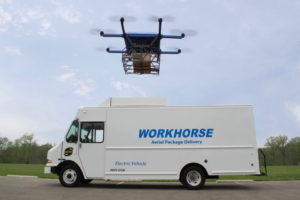
Transportation-solutions provider Workhorse Group flew to new heights over the second quarter of 2020.
According to a firm press release, the Cincinnati-based company recorded several major financial benchmarks ending June 30 of Q2, including:
- Q2 sales at $92,000 compared to $5,500 in the second quarter of 2019.
- Cost of goods sold increased to $1.5 million from $930,000 in Q2 of 2019.
- Selling, general and administrative expenses increase to $3.9 million from $2 million in the same period last year. The increase was due primarily to increases in consulting expenses, higher employee related costs and incentive stock expenses.
In the drone space, Workhorse has partnered with Unmanned Systems Operations Group to launch a pilot drone-delivery program focusing on the medical sector. The initiative deploys Workhorse’s HorseFly, an octocopter drone designed and built by the University of Cincinnati College of Engineering and Applied Science.
In addition, the company has filed a patent to develop a truck-launched drone package delivery system. Dubbed a custom-built, high efficiency delivery drone fully integrated with the Workhorse line of electric/hybrid delivery trucks, the Horsefly is designed to be FAA compliant, and will integrate with delivery trucks to maintain line-of-sight flights with a driver or assistant.
In addition, Workhorse made new strides in the arena of electric vehicles and batteries. Last month, the company delivered two C-1000 electric step vans for initial use through Ryder System, Inc.’s ChoiceLease and SelectCare product lines, as well as for short-term rentals on COOP by Ryder program, a peer-to-peer truck sharing platform.
Workhorse also became the first and only medium duty battery electric vehicle (BEV) OEM to receive approvals from both the EPA as well as the California Air Resources Board (CARB), permitting the company to sell vehicles in all 50 states.
“In the first half of this year we accomplished a series of major operational and EV industry milestones, culminating in the first official deliveries of our C-Series trucks to Ryder just a few weeks ago,” said Workhorse CEO Duane Hughes.
“Additionally, after acquiring the requisite various state and federal approvals in recent months, we are now the only medium duty BEV OEM permitted and able to sell and deliver our vehicles in all 50 states, which should allow us to further distance ourselves as the first movers in the last-mile EV space. Widening our sales funnel through tax incentives, government programs and strategic partnerships, all of which we now have, will allow us greater opportunities to build on our growing backlog. We are now focusing on maximizing our efficiency and output as we look to ramp production throughout the remainder of this year to meet our ambitious delivery campaign goals.”
Jason is a longstanding contributor to DroneLife with an avid interest in all things tech. He focuses on anti-drone technologies and the public safety sector; police, fire, and search and rescue.
Beginning his career as a journalist in 1996, Jason has since written and edited thousands of engaging news articles, blog posts, press releases and online content.
Email Jason
TWITTER:@JasonPReagan
Subscribe to DroneLife here.